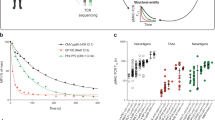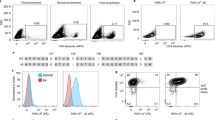Abstract
Therapeutic vaccination of cancer patients with dendritic cells aims at inducing a strong tumor-specific T-cell response. Testing new target antigens for their immunogenicity is crucial to evaluate their suitability for this approach. Here we demonstrate a comfortable and reliable method to detect antigen-specific CD8+ T-cell responses without the knowledge of the precise T-cell epitope and without the usage of additional target cells. We used the CD8+ T cells themselves and electroporated them with RNA encoding the respective tumor antigen. The cells expressed, processed and presented the antigen and were capable of stimulating each other in functional readouts. For the model antigen MelanA, the number of interferon-γ-secreting cells obtained with this method highly correlated with the numbers obtained by exogenous peptide loading (R2=0.8). The method was also applicable for the tumor-associated antigen Wilms’ tumor protein 1. This system is quick and easy to perform, independent of the donors human leukocyte antigen type and circumvents the need for additional cells as targets. It can be used in preclinical research to test new antigens for their immunogenic potential and for immunomonitoring in cancer patients.
This is a preview of subscription content, access via your institution
Access options
Subscribe to this journal
Receive 12 print issues and online access
$259.00 per year
only $21.58 per issue
Buy this article
- Purchase on Springer Link
- Instant access to full article PDF
Prices may be subject to local taxes which are calculated during checkout



Similar content being viewed by others
References
Van Nuffel AM, Wilgenhof S, Thielemans K, Bonehill A . Overcoming HLA restriction in clinical trials: immune monitoring of mRNA-loaded DC therapy. Oncoimmunology 2012; 1: 1392–1394.
Schuler G, Schuler-Thurner B, Steinman RM . The use of dendritic cells in cancer immunotherapy. Curr Opin Immunol 2003; 15: 138–147.
Garg NK, Dwivedi P, Prabha P, Tyagi RK . RNA pulsed dendritic cells: an approach for cancer immunotherapy. Vaccine 2013; 31: 1141–1156.
Malmberg KJ . Effective immunotherapy against cancer: a question of overcoming immune suppression and immune escape? Cancer Immunol Immunother 2004; 53: 879–892.
Holtkamp S, Kreiter S, Selmi A, Simon P, Koslowski M, Huber C et al. Modification of antigen-encoding RNA increases stability, translational efficacy, and T-cell stimulatory capacity of dendritic cells. Blood 2006; 108: 4009–4017.
Fearnley DB, Whyte LF, Carnoutsos SA, Cook AH, Hart DN . Monitoring human blood dendritic cell numbers in normal individuals and in stem cell transplantation. Blood 1999; 93: 728–736.
Knight SC, Burke F, Bedford PA . Dendritic cells, antigen distribution and the initiation of primary immune responses to self and non-self antigens. Semin Cancer Biol 2002; 12: 301–308.
Coulie PG, Brichard V, Van Pel A, Wölfel T, Schneider J, Traversari C et al. A new gene coding for a differentiation antigen recognized by autologous cytolytic T lymphocytes on HLA-A2 melanomas. J Exp Med 1994; 180: 35–42.
Kawakami Y, Eliyahu S, Sakaguchi K, Robbins PF, Rivoltini L, Yannelli JR et al. Identification of the immunodominant peptides of the MART-1 human melanoma antigen recognized by the majority of HLA-A2-restricted tumor infiltrating lymphocytes. J Exp Med 1994; 180: 347–352.
Benlalam H, Vignard V, Khammari A, Bonnin A, Godet Y, Pandolfino MC et al. Infusion of Melan-A/Mart-1 specific tumor-infiltrating lymphocytes enhanced relapse-free survival of melanoma patients. Cancer Immunol Immunother 2007; 56: 515–526.
Banchereau J, Ueno H, Dhodapkar M, Connolly J, Finholt JP, Klechevsky E et al. Immune and clinical outcomes in patients with stage IV melanoma vaccinated with peptide-pulsed dendritic cells derived from CD34+ progenitors and activated with type I interferon. J Immunother 2005; 28: 505–516.
Johnson LA, Morgan RA, Dudley ME, Cassard L, Yang JC, Hughes MS et al. Gene therapy with human and mouse T-cell receptors mediates cancer regression and targets normal tissues expressing cognate antigen. Blood 2009; 114: 535–546.
Inoue K1, Ogawa H, Sonoda Y, Kimura T, Sakabe H, Oka Y et al. Aberrant overexpression of the Wilms tumor gene (WT1) in human leukemia. Blood 1997; 89: 1405–1412.
Loeb DM, Evron E, Patel CB, Sharma PM, Niranjan B, Buluwela L et al. Wilms' tumor suppressor gene (WT1) is expressed in primary breast tumors despite tumor-specific promoter methylation. Cancer Res 2001; 61: 921–925.
Oji Y1, Miyoshi S, Maeda H, Hayashi S, Tamaki H, Nakatsuka S et al. Overexpression of the Wilms' tumor gene WT1 in de novo lung cancers. Int J Cancer 2002; 100: 297–303.
Wegert J, Bausenwein S, Roth S, Graf N, Geissinger E, Gessler M . Characterization of primary Wilms tumor cultures as an in vitro model. Genes Chromosomes Cancer 2012; 51: 92–104.
Pfeiffer IA, Hoyer S, Gerer KF, Voll RE, Knippertz I, Gückel E et al. Triggering of NF-κB in cytokine-matured human DCs generates superior DCs for T-cell priming in cancer immunotherapy. Eur J Immunol 2014; 44: 3413–3428.
Saebøe-Larssen S, Fossberg E, Gaudernack G . mRNA-based electrotransfection of human dendritic cells and induction of cytotoxic T lymphocyte responses against the telomerase catalytic subunit (hTERT). J Immunol Methods 2002; 259: 191–203.
Jäger E, Höhn H, Karbach J, Momburg F, Castelli C, Knuth A et al. Cytotoxic T lymphocytes define multiple peptide isoforms derived from the melanoma-associated antigen MART-1/Melan-A. Int J Cancer 1999; 81: 979–984.
Etschel JK, Hückelhoven AG, Hofmann C, Zitzelsberger K, Maurer K, Bergmann S et al. HIV-1 mRNA electroporation of PBMC: a simple and efficient method to monitor T-cell responses against autologous HIV-1 in HIV-1-infected patients. J Immunol Methods 2012; 380: 40–55.
Van Camp K, Cools N, Stein B, Van de Velde A, Goossens H, Berneman ZN et al. Efficient mRNA electroporation of peripheral blood mononuclear cells to detect memory T cell responses for immunomonitoring purposes. J Immunol Methods 2010; 354: 1–10.
Doubrovina E, Carpenter T, Pankov D, Selvakumar A, Hasan A, O'Reilly RJ . Mapping of novel peptides of WT-1 and presenting HLA alleles that induce epitope-specific HLA-restricted T cells with cytotoxic activity against WT-1(+) leukemias. Blood 2012; 120: 1633–1646.
Bachinsky MM, Guillen DE, Patel SR, Singleton J, Chen C, Soltis DA et al. Mapping and binding analysis of peptides derived from the tumor-associated antigen survivin for eight HLA alleles. Cancer Immun 2005; 5: 6.
Schaft N, Dörrie J, Thumann P, Beck VE, Müller I, Schultz ES et al. Generation of an optimized polyvalent monocyte-derived dendritic cell vaccine by transfecting defined RNAs after rather than before maturation. J Immunol 2005; 174: 3087–3097.
Acknowledgements
We thank Carmen Lorenz, Waltraud Leisgang, Stefanie Baumann and Verena Wellner for excellent technical assistance, and the medical staff for acquisition of donor material. We acknowledge the assistance of the Core Unit Cell Sorting and Immunomonitoring Erlangen of the Collaborative Research Centre SFB643 (project Z2). This work was partially financed by the BMBF (project DCmutaVacc, Förderkennzeichen 01GU1107A to GS) and the German Cancer Aid (Deutsche Krebshilfe e.V.; 110265 to JD, BST and NS).
Author information
Authors and Affiliations
Corresponding author
Ethics declarations
Competing interests
The authors declare no conflict of interest to declare.
Rights and permissions
About this article
Cite this article
Prommersberger, S., Höfflin, S., Schuler-Thurner, B. et al. A new method to monitor antigen-specific CD8+ T cells, avoiding additional target cells and the restriction to human leukocyte antigen haplotype. Gene Ther 22, 516–520 (2015). https://doi.org/10.1038/gt.2015.15
Received:
Revised:
Accepted:
Published:
Issue Date:
DOI: https://doi.org/10.1038/gt.2015.15



